Management and Operations Report: Uber Technologies Inc. Analysis
VerifiedAdded on 2023/01/03
|11
|4381
|72
Report
AI Summary
This report provides an in-depth analysis of management and operations within Uber Technologies Inc. It begins by defining and comparing the roles and characteristics of leaders and managers, examining their application in various situational contexts. The report then delves into different leadership theories and models, including situational leadership, systems leadership, and contingency theory, illustrating their practical implementation within the company. Furthermore, the report explains key approaches to operations management and the roles of leaders and managers in achieving business objectives. It assesses the impact of the business environment on operational management and decision-making, providing a comprehensive overview of Uber's operational strategies and their effectiveness. The report is structured to address specific learning outcomes, offering insights into leadership, management, and operational strategies within a real-world business context.
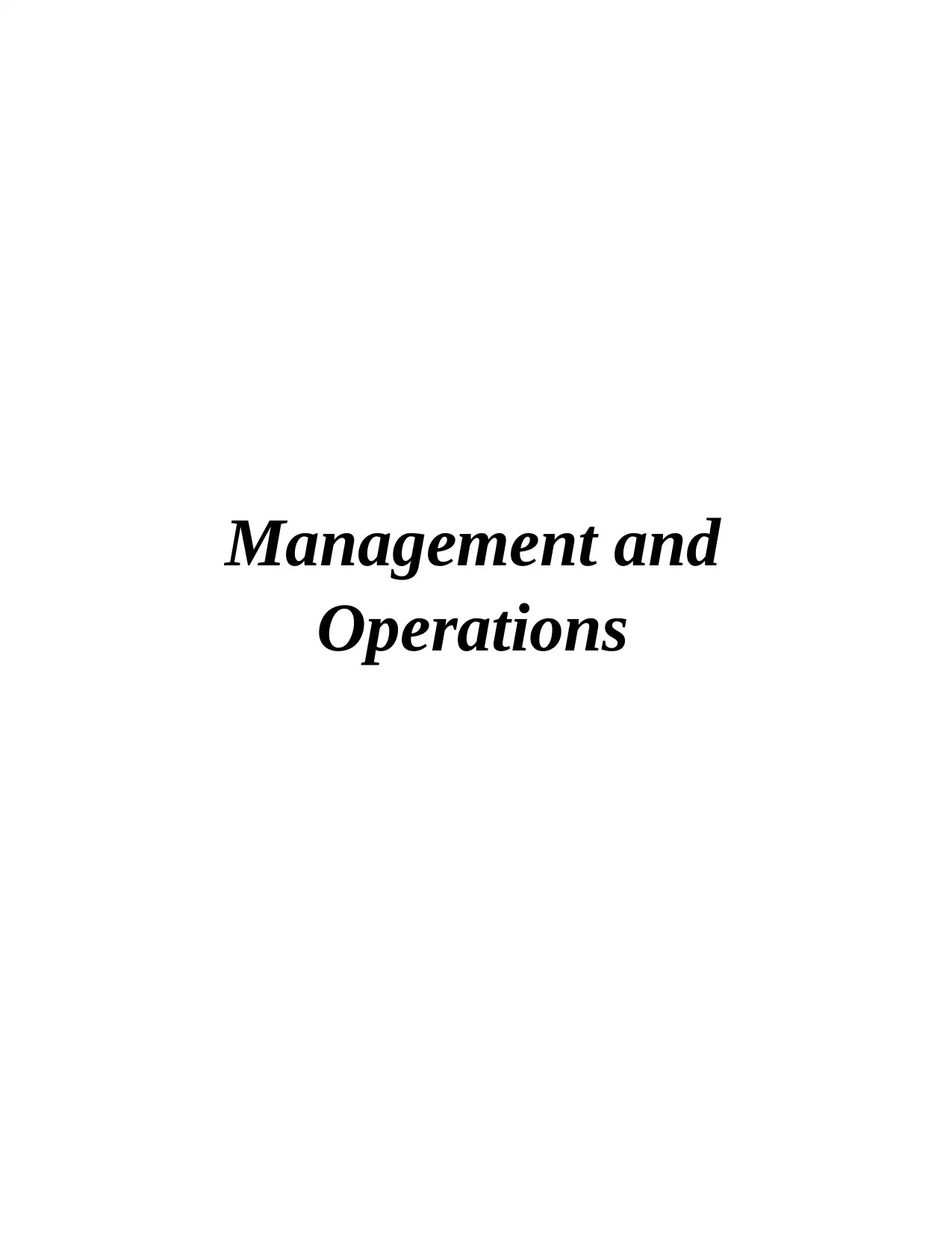
Management and
Operations
Operations
Paraphrase This Document
Need a fresh take? Get an instant paraphrase of this document with our AI Paraphraser
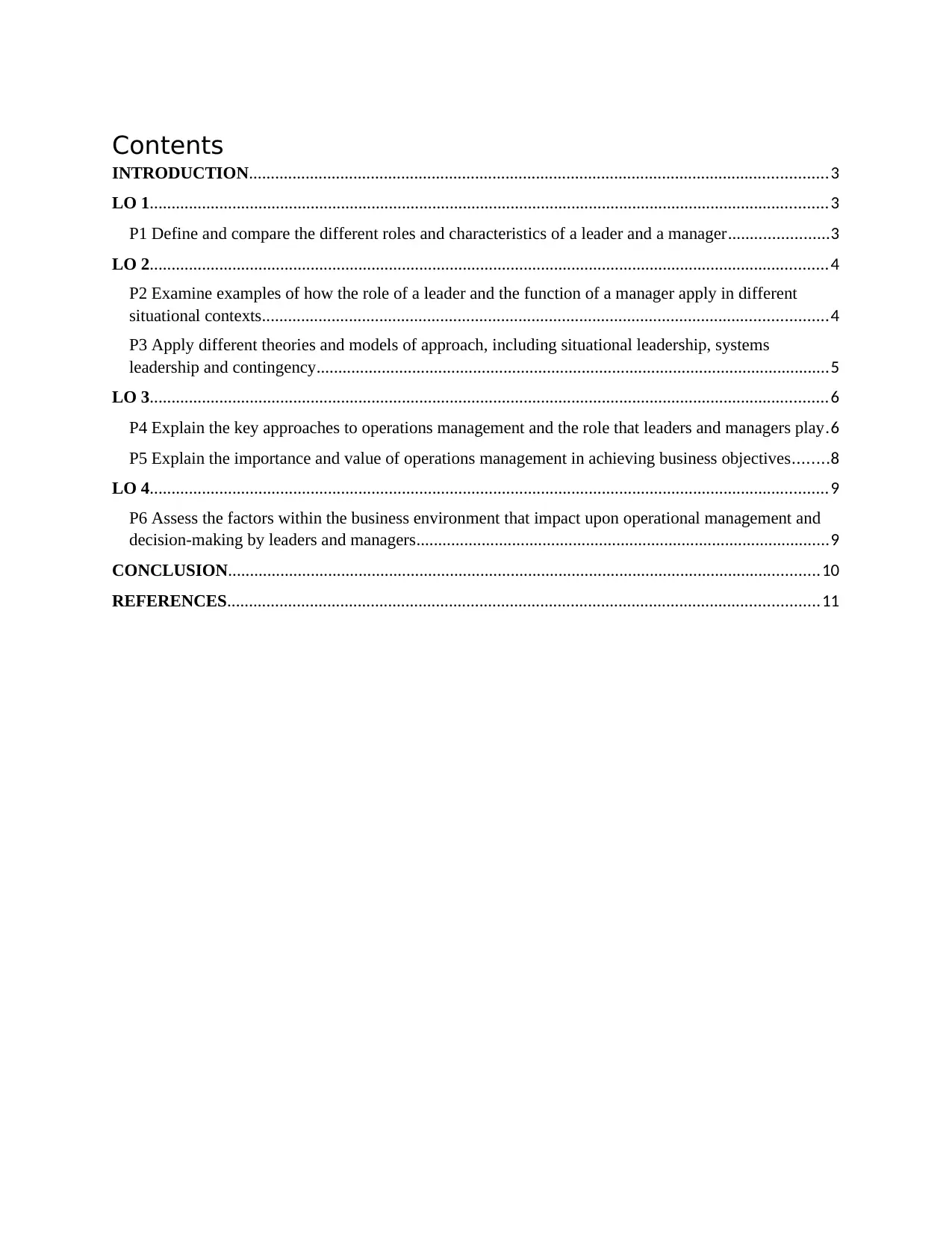
Contents
INTRODUCTION.....................................................................................................................................3
LO 1............................................................................................................................................................3
P1 Define and compare the different roles and characteristics of a leader and a manager.......................3
LO 2............................................................................................................................................................4
P2 Examine examples of how the role of a leader and the function of a manager apply in different
situational contexts..................................................................................................................................4
P3 Apply different theories and models of approach, including situational leadership, systems
leadership and contingency......................................................................................................................5
LO 3............................................................................................................................................................6
P4 Explain the key approaches to operations management and the role that leaders and managers play.6
P5 Explain the importance and value of operations management in achieving business objectives........8
LO 4............................................................................................................................................................9
P6 Assess the factors within the business environment that impact upon operational management and
decision-making by leaders and managers...............................................................................................9
CONCLUSION........................................................................................................................................10
REFERENCES........................................................................................................................................11
INTRODUCTION.....................................................................................................................................3
LO 1............................................................................................................................................................3
P1 Define and compare the different roles and characteristics of a leader and a manager.......................3
LO 2............................................................................................................................................................4
P2 Examine examples of how the role of a leader and the function of a manager apply in different
situational contexts..................................................................................................................................4
P3 Apply different theories and models of approach, including situational leadership, systems
leadership and contingency......................................................................................................................5
LO 3............................................................................................................................................................6
P4 Explain the key approaches to operations management and the role that leaders and managers play.6
P5 Explain the importance and value of operations management in achieving business objectives........8
LO 4............................................................................................................................................................9
P6 Assess the factors within the business environment that impact upon operational management and
decision-making by leaders and managers...............................................................................................9
CONCLUSION........................................................................................................................................10
REFERENCES........................................................................................................................................11
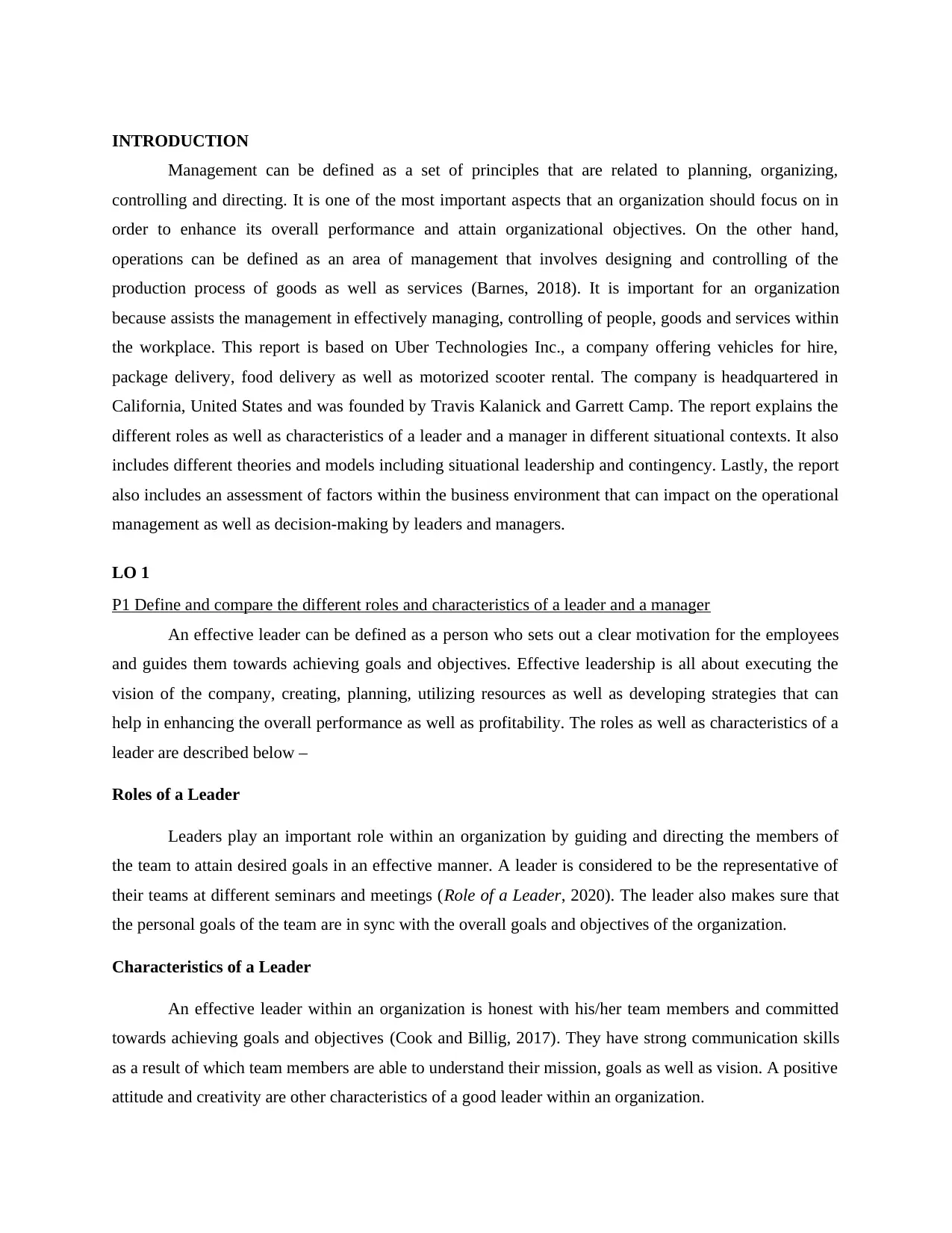
INTRODUCTION
Management can be defined as a set of principles that are related to planning, organizing,
controlling and directing. It is one of the most important aspects that an organization should focus on in
order to enhance its overall performance and attain organizational objectives. On the other hand,
operations can be defined as an area of management that involves designing and controlling of the
production process of goods as well as services (Barnes, 2018). It is important for an organization
because assists the management in effectively managing, controlling of people, goods and services within
the workplace. This report is based on Uber Technologies Inc., a company offering vehicles for hire,
package delivery, food delivery as well as motorized scooter rental. The company is headquartered in
California, United States and was founded by Travis Kalanick and Garrett Camp. The report explains the
different roles as well as characteristics of a leader and a manager in different situational contexts. It also
includes different theories and models including situational leadership and contingency. Lastly, the report
also includes an assessment of factors within the business environment that can impact on the operational
management as well as decision-making by leaders and managers.
LO 1
P1 Define and compare the different roles and characteristics of a leader and a manager
An effective leader can be defined as a person who sets out a clear motivation for the employees
and guides them towards achieving goals and objectives. Effective leadership is all about executing the
vision of the company, creating, planning, utilizing resources as well as developing strategies that can
help in enhancing the overall performance as well as profitability. The roles as well as characteristics of a
leader are described below –
Roles of a Leader
Leaders play an important role within an organization by guiding and directing the members of
the team to attain desired goals in an effective manner. A leader is considered to be the representative of
their teams at different seminars and meetings (Role of a Leader, 2020). The leader also makes sure that
the personal goals of the team are in sync with the overall goals and objectives of the organization.
Characteristics of a Leader
An effective leader within an organization is honest with his/her team members and committed
towards achieving goals and objectives (Cook and Billig, 2017). They have strong communication skills
as a result of which team members are able to understand their mission, goals as well as vision. A positive
attitude and creativity are other characteristics of a good leader within an organization.
Management can be defined as a set of principles that are related to planning, organizing,
controlling and directing. It is one of the most important aspects that an organization should focus on in
order to enhance its overall performance and attain organizational objectives. On the other hand,
operations can be defined as an area of management that involves designing and controlling of the
production process of goods as well as services (Barnes, 2018). It is important for an organization
because assists the management in effectively managing, controlling of people, goods and services within
the workplace. This report is based on Uber Technologies Inc., a company offering vehicles for hire,
package delivery, food delivery as well as motorized scooter rental. The company is headquartered in
California, United States and was founded by Travis Kalanick and Garrett Camp. The report explains the
different roles as well as characteristics of a leader and a manager in different situational contexts. It also
includes different theories and models including situational leadership and contingency. Lastly, the report
also includes an assessment of factors within the business environment that can impact on the operational
management as well as decision-making by leaders and managers.
LO 1
P1 Define and compare the different roles and characteristics of a leader and a manager
An effective leader can be defined as a person who sets out a clear motivation for the employees
and guides them towards achieving goals and objectives. Effective leadership is all about executing the
vision of the company, creating, planning, utilizing resources as well as developing strategies that can
help in enhancing the overall performance as well as profitability. The roles as well as characteristics of a
leader are described below –
Roles of a Leader
Leaders play an important role within an organization by guiding and directing the members of
the team to attain desired goals in an effective manner. A leader is considered to be the representative of
their teams at different seminars and meetings (Role of a Leader, 2020). The leader also makes sure that
the personal goals of the team are in sync with the overall goals and objectives of the organization.
Characteristics of a Leader
An effective leader within an organization is honest with his/her team members and committed
towards achieving goals and objectives (Cook and Billig, 2017). They have strong communication skills
as a result of which team members are able to understand their mission, goals as well as vision. A positive
attitude and creativity are other characteristics of a good leader within an organization.
⊘ This is a preview!⊘
Do you want full access?
Subscribe today to unlock all pages.

Trusted by 1+ million students worldwide
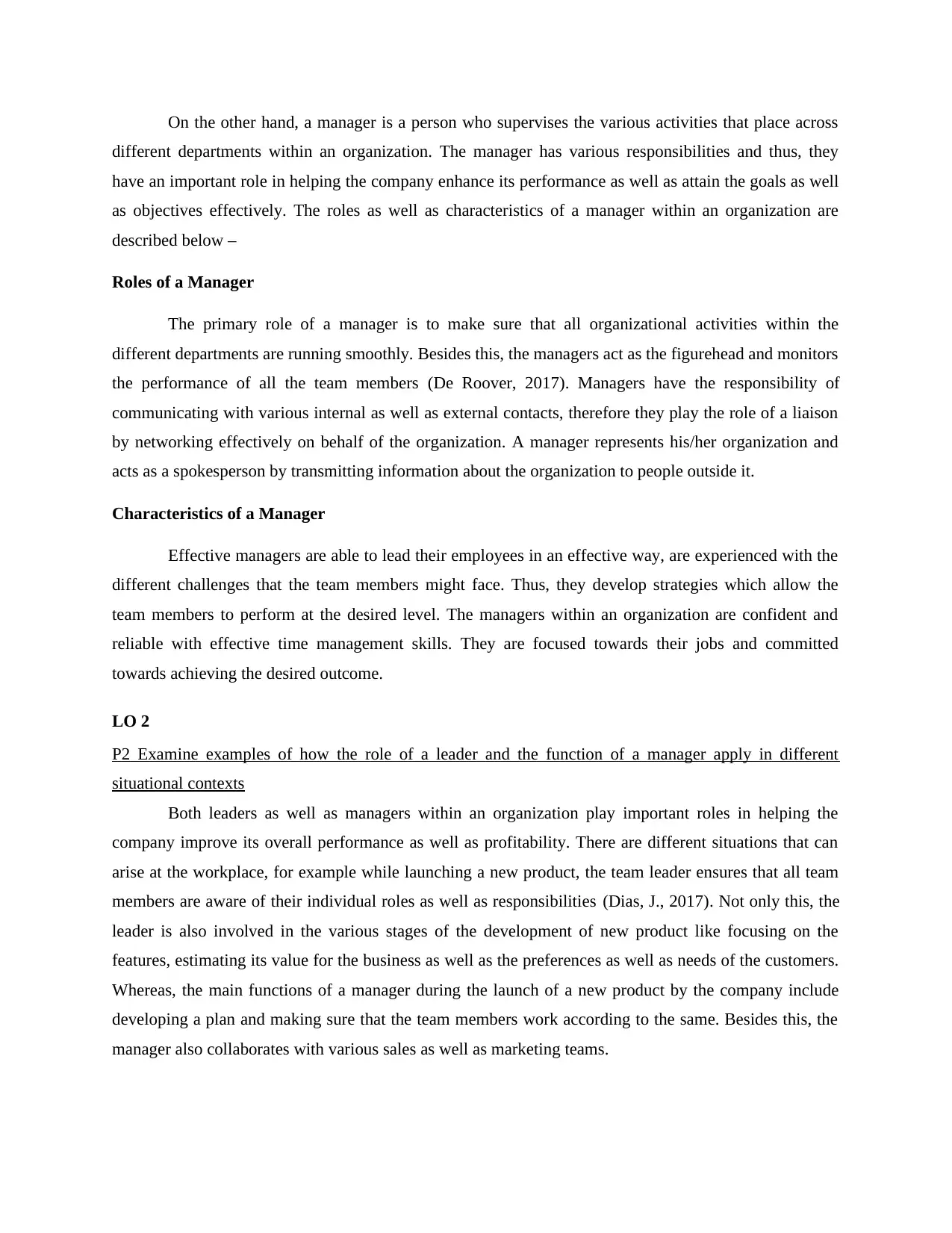
On the other hand, a manager is a person who supervises the various activities that place across
different departments within an organization. The manager has various responsibilities and thus, they
have an important role in helping the company enhance its performance as well as attain the goals as well
as objectives effectively. The roles as well as characteristics of a manager within an organization are
described below –
Roles of a Manager
The primary role of a manager is to make sure that all organizational activities within the
different departments are running smoothly. Besides this, the managers act as the figurehead and monitors
the performance of all the team members (De Roover, 2017). Managers have the responsibility of
communicating with various internal as well as external contacts, therefore they play the role of a liaison
by networking effectively on behalf of the organization. A manager represents his/her organization and
acts as a spokesperson by transmitting information about the organization to people outside it.
Characteristics of a Manager
Effective managers are able to lead their employees in an effective way, are experienced with the
different challenges that the team members might face. Thus, they develop strategies which allow the
team members to perform at the desired level. The managers within an organization are confident and
reliable with effective time management skills. They are focused towards their jobs and committed
towards achieving the desired outcome.
LO 2
P2 Examine examples of how the role of a leader and the function of a manager apply in different
situational contexts
Both leaders as well as managers within an organization play important roles in helping the
company improve its overall performance as well as profitability. There are different situations that can
arise at the workplace, for example while launching a new product, the team leader ensures that all team
members are aware of their individual roles as well as responsibilities (Dias, J., 2017). Not only this, the
leader is also involved in the various stages of the development of new product like focusing on the
features, estimating its value for the business as well as the preferences as well as needs of the customers.
Whereas, the main functions of a manager during the launch of a new product by the company include
developing a plan and making sure that the team members work according to the same. Besides this, the
manager also collaborates with various sales as well as marketing teams.
different departments within an organization. The manager has various responsibilities and thus, they
have an important role in helping the company enhance its performance as well as attain the goals as well
as objectives effectively. The roles as well as characteristics of a manager within an organization are
described below –
Roles of a Manager
The primary role of a manager is to make sure that all organizational activities within the
different departments are running smoothly. Besides this, the managers act as the figurehead and monitors
the performance of all the team members (De Roover, 2017). Managers have the responsibility of
communicating with various internal as well as external contacts, therefore they play the role of a liaison
by networking effectively on behalf of the organization. A manager represents his/her organization and
acts as a spokesperson by transmitting information about the organization to people outside it.
Characteristics of a Manager
Effective managers are able to lead their employees in an effective way, are experienced with the
different challenges that the team members might face. Thus, they develop strategies which allow the
team members to perform at the desired level. The managers within an organization are confident and
reliable with effective time management skills. They are focused towards their jobs and committed
towards achieving the desired outcome.
LO 2
P2 Examine examples of how the role of a leader and the function of a manager apply in different
situational contexts
Both leaders as well as managers within an organization play important roles in helping the
company improve its overall performance as well as profitability. There are different situations that can
arise at the workplace, for example while launching a new product, the team leader ensures that all team
members are aware of their individual roles as well as responsibilities (Dias, J., 2017). Not only this, the
leader is also involved in the various stages of the development of new product like focusing on the
features, estimating its value for the business as well as the preferences as well as needs of the customers.
Whereas, the main functions of a manager during the launch of a new product by the company include
developing a plan and making sure that the team members work according to the same. Besides this, the
manager also collaborates with various sales as well as marketing teams.
Paraphrase This Document
Need a fresh take? Get an instant paraphrase of this document with our AI Paraphraser
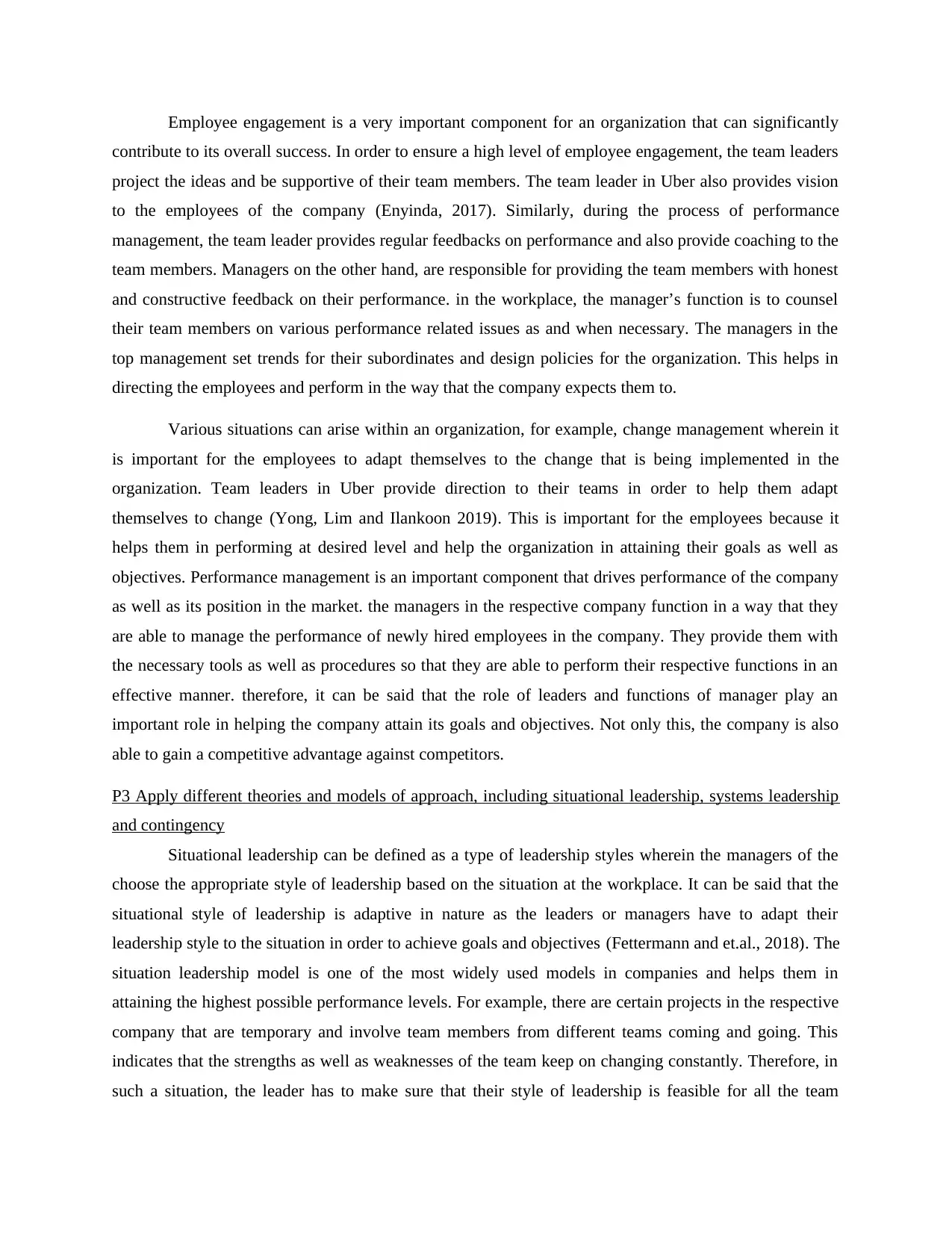
Employee engagement is a very important component for an organization that can significantly
contribute to its overall success. In order to ensure a high level of employee engagement, the team leaders
project the ideas and be supportive of their team members. The team leader in Uber also provides vision
to the employees of the company (Enyinda, 2017). Similarly, during the process of performance
management, the team leader provides regular feedbacks on performance and also provide coaching to the
team members. Managers on the other hand, are responsible for providing the team members with honest
and constructive feedback on their performance. in the workplace, the manager’s function is to counsel
their team members on various performance related issues as and when necessary. The managers in the
top management set trends for their subordinates and design policies for the organization. This helps in
directing the employees and perform in the way that the company expects them to.
Various situations can arise within an organization, for example, change management wherein it
is important for the employees to adapt themselves to the change that is being implemented in the
organization. Team leaders in Uber provide direction to their teams in order to help them adapt
themselves to change (Yong, Lim and Ilankoon 2019). This is important for the employees because it
helps them in performing at desired level and help the organization in attaining their goals as well as
objectives. Performance management is an important component that drives performance of the company
as well as its position in the market. the managers in the respective company function in a way that they
are able to manage the performance of newly hired employees in the company. They provide them with
the necessary tools as well as procedures so that they are able to perform their respective functions in an
effective manner. therefore, it can be said that the role of leaders and functions of manager play an
important role in helping the company attain its goals and objectives. Not only this, the company is also
able to gain a competitive advantage against competitors.
P3 Apply different theories and models of approach, including situational leadership, systems leadership
and contingency
Situational leadership can be defined as a type of leadership styles wherein the managers of the
choose the appropriate style of leadership based on the situation at the workplace. It can be said that the
situational style of leadership is adaptive in nature as the leaders or managers have to adapt their
leadership style to the situation in order to achieve goals and objectives (Fettermann and et.al., 2018). The
situation leadership model is one of the most widely used models in companies and helps them in
attaining the highest possible performance levels. For example, there are certain projects in the respective
company that are temporary and involve team members from different teams coming and going. This
indicates that the strengths as well as weaknesses of the team keep on changing constantly. Therefore, in
such a situation, the leader has to make sure that their style of leadership is feasible for all the team
contribute to its overall success. In order to ensure a high level of employee engagement, the team leaders
project the ideas and be supportive of their team members. The team leader in Uber also provides vision
to the employees of the company (Enyinda, 2017). Similarly, during the process of performance
management, the team leader provides regular feedbacks on performance and also provide coaching to the
team members. Managers on the other hand, are responsible for providing the team members with honest
and constructive feedback on their performance. in the workplace, the manager’s function is to counsel
their team members on various performance related issues as and when necessary. The managers in the
top management set trends for their subordinates and design policies for the organization. This helps in
directing the employees and perform in the way that the company expects them to.
Various situations can arise within an organization, for example, change management wherein it
is important for the employees to adapt themselves to the change that is being implemented in the
organization. Team leaders in Uber provide direction to their teams in order to help them adapt
themselves to change (Yong, Lim and Ilankoon 2019). This is important for the employees because it
helps them in performing at desired level and help the organization in attaining their goals as well as
objectives. Performance management is an important component that drives performance of the company
as well as its position in the market. the managers in the respective company function in a way that they
are able to manage the performance of newly hired employees in the company. They provide them with
the necessary tools as well as procedures so that they are able to perform their respective functions in an
effective manner. therefore, it can be said that the role of leaders and functions of manager play an
important role in helping the company attain its goals and objectives. Not only this, the company is also
able to gain a competitive advantage against competitors.
P3 Apply different theories and models of approach, including situational leadership, systems leadership
and contingency
Situational leadership can be defined as a type of leadership styles wherein the managers of the
choose the appropriate style of leadership based on the situation at the workplace. It can be said that the
situational style of leadership is adaptive in nature as the leaders or managers have to adapt their
leadership style to the situation in order to achieve goals and objectives (Fettermann and et.al., 2018). The
situation leadership model is one of the most widely used models in companies and helps them in
attaining the highest possible performance levels. For example, there are certain projects in the respective
company that are temporary and involve team members from different teams coming and going. This
indicates that the strengths as well as weaknesses of the team keep on changing constantly. Therefore, in
such a situation, the leader has to make sure that their style of leadership is feasible for all the team
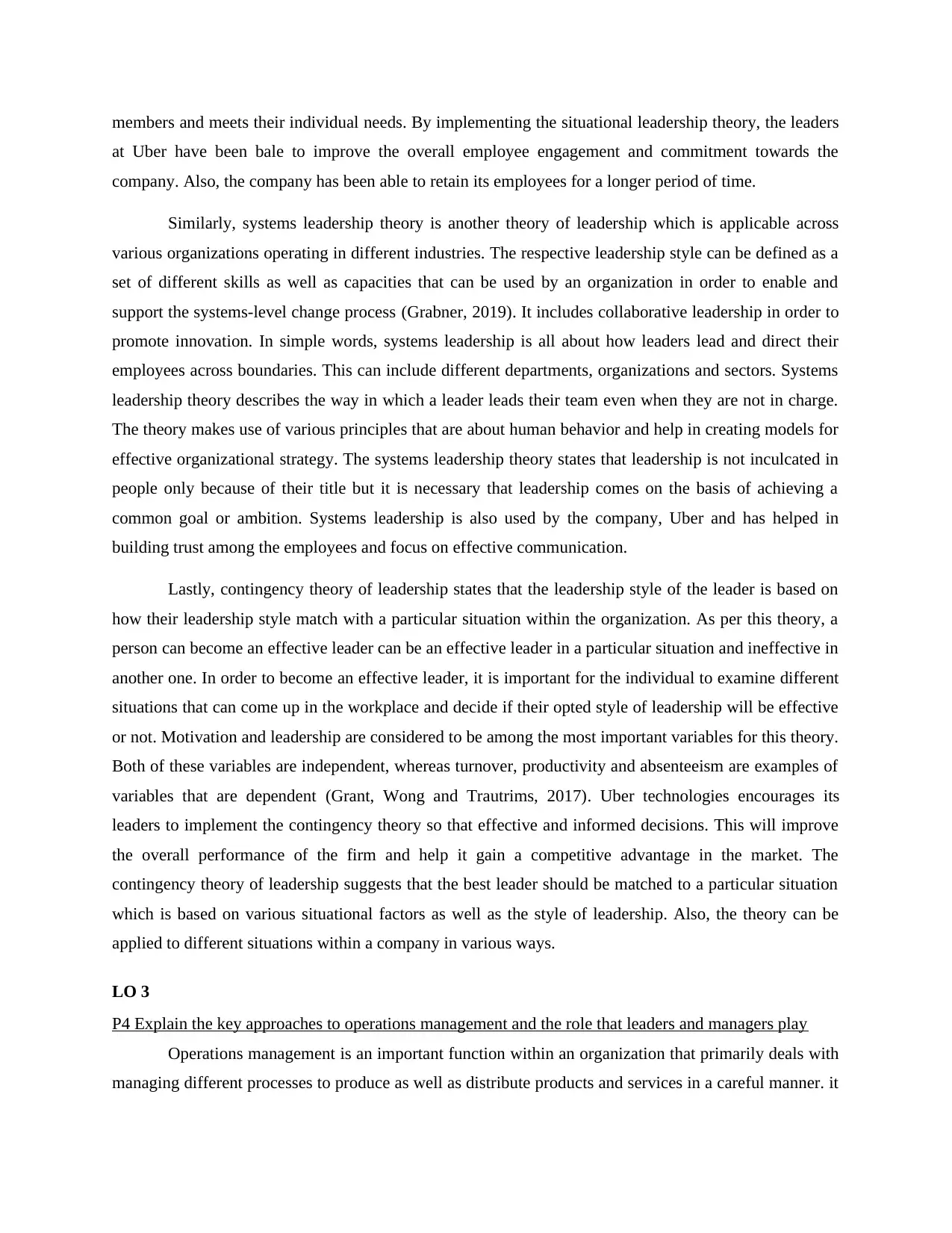
members and meets their individual needs. By implementing the situational leadership theory, the leaders
at Uber have been bale to improve the overall employee engagement and commitment towards the
company. Also, the company has been able to retain its employees for a longer period of time.
Similarly, systems leadership theory is another theory of leadership which is applicable across
various organizations operating in different industries. The respective leadership style can be defined as a
set of different skills as well as capacities that can be used by an organization in order to enable and
support the systems-level change process (Grabner, 2019). It includes collaborative leadership in order to
promote innovation. In simple words, systems leadership is all about how leaders lead and direct their
employees across boundaries. This can include different departments, organizations and sectors. Systems
leadership theory describes the way in which a leader leads their team even when they are not in charge.
The theory makes use of various principles that are about human behavior and help in creating models for
effective organizational strategy. The systems leadership theory states that leadership is not inculcated in
people only because of their title but it is necessary that leadership comes on the basis of achieving a
common goal or ambition. Systems leadership is also used by the company, Uber and has helped in
building trust among the employees and focus on effective communication.
Lastly, contingency theory of leadership states that the leadership style of the leader is based on
how their leadership style match with a particular situation within the organization. As per this theory, a
person can become an effective leader can be an effective leader in a particular situation and ineffective in
another one. In order to become an effective leader, it is important for the individual to examine different
situations that can come up in the workplace and decide if their opted style of leadership will be effective
or not. Motivation and leadership are considered to be among the most important variables for this theory.
Both of these variables are independent, whereas turnover, productivity and absenteeism are examples of
variables that are dependent (Grant, Wong and Trautrims, 2017). Uber technologies encourages its
leaders to implement the contingency theory so that effective and informed decisions. This will improve
the overall performance of the firm and help it gain a competitive advantage in the market. The
contingency theory of leadership suggests that the best leader should be matched to a particular situation
which is based on various situational factors as well as the style of leadership. Also, the theory can be
applied to different situations within a company in various ways.
LO 3
P4 Explain the key approaches to operations management and the role that leaders and managers play
Operations management is an important function within an organization that primarily deals with
managing different processes to produce as well as distribute products and services in a careful manner. it
at Uber have been bale to improve the overall employee engagement and commitment towards the
company. Also, the company has been able to retain its employees for a longer period of time.
Similarly, systems leadership theory is another theory of leadership which is applicable across
various organizations operating in different industries. The respective leadership style can be defined as a
set of different skills as well as capacities that can be used by an organization in order to enable and
support the systems-level change process (Grabner, 2019). It includes collaborative leadership in order to
promote innovation. In simple words, systems leadership is all about how leaders lead and direct their
employees across boundaries. This can include different departments, organizations and sectors. Systems
leadership theory describes the way in which a leader leads their team even when they are not in charge.
The theory makes use of various principles that are about human behavior and help in creating models for
effective organizational strategy. The systems leadership theory states that leadership is not inculcated in
people only because of their title but it is necessary that leadership comes on the basis of achieving a
common goal or ambition. Systems leadership is also used by the company, Uber and has helped in
building trust among the employees and focus on effective communication.
Lastly, contingency theory of leadership states that the leadership style of the leader is based on
how their leadership style match with a particular situation within the organization. As per this theory, a
person can become an effective leader can be an effective leader in a particular situation and ineffective in
another one. In order to become an effective leader, it is important for the individual to examine different
situations that can come up in the workplace and decide if their opted style of leadership will be effective
or not. Motivation and leadership are considered to be among the most important variables for this theory.
Both of these variables are independent, whereas turnover, productivity and absenteeism are examples of
variables that are dependent (Grant, Wong and Trautrims, 2017). Uber technologies encourages its
leaders to implement the contingency theory so that effective and informed decisions. This will improve
the overall performance of the firm and help it gain a competitive advantage in the market. The
contingency theory of leadership suggests that the best leader should be matched to a particular situation
which is based on various situational factors as well as the style of leadership. Also, the theory can be
applied to different situations within a company in various ways.
LO 3
P4 Explain the key approaches to operations management and the role that leaders and managers play
Operations management is an important function within an organization that primarily deals with
managing different processes to produce as well as distribute products and services in a careful manner. it
⊘ This is a preview!⊘
Do you want full access?
Subscribe today to unlock all pages.

Trusted by 1+ million students worldwide
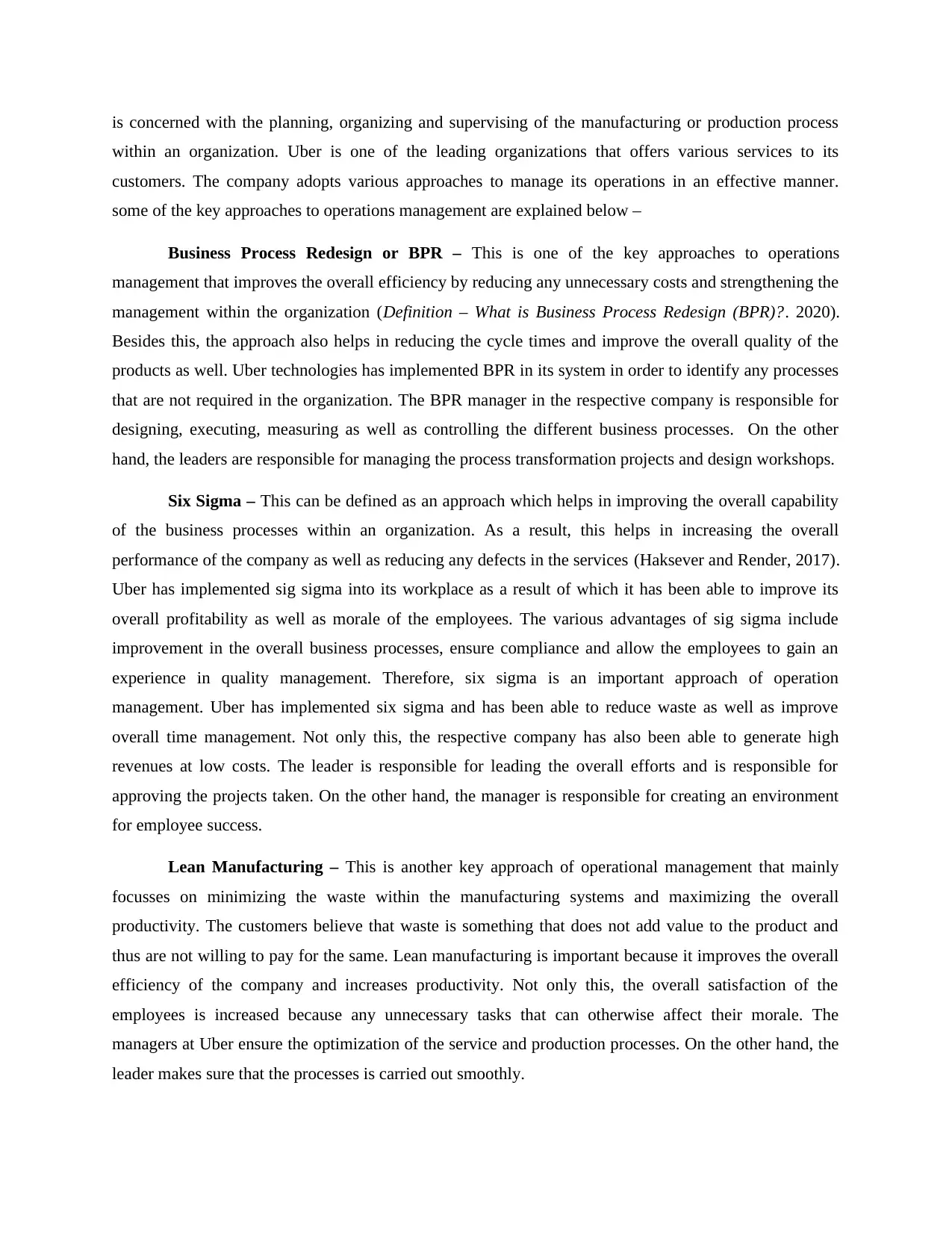
is concerned with the planning, organizing and supervising of the manufacturing or production process
within an organization. Uber is one of the leading organizations that offers various services to its
customers. The company adopts various approaches to manage its operations in an effective manner.
some of the key approaches to operations management are explained below –
Business Process Redesign or BPR – This is one of the key approaches to operations
management that improves the overall efficiency by reducing any unnecessary costs and strengthening the
management within the organization (Definition – What is Business Process Redesign (BPR)?. 2020).
Besides this, the approach also helps in reducing the cycle times and improve the overall quality of the
products as well. Uber technologies has implemented BPR in its system in order to identify any processes
that are not required in the organization. The BPR manager in the respective company is responsible for
designing, executing, measuring as well as controlling the different business processes. On the other
hand, the leaders are responsible for managing the process transformation projects and design workshops.
Six Sigma – This can be defined as an approach which helps in improving the overall capability
of the business processes within an organization. As a result, this helps in increasing the overall
performance of the company as well as reducing any defects in the services (Haksever and Render, 2017).
Uber has implemented sig sigma into its workplace as a result of which it has been able to improve its
overall profitability as well as morale of the employees. The various advantages of sig sigma include
improvement in the overall business processes, ensure compliance and allow the employees to gain an
experience in quality management. Therefore, six sigma is an important approach of operation
management. Uber has implemented six sigma and has been able to reduce waste as well as improve
overall time management. Not only this, the respective company has also been able to generate high
revenues at low costs. The leader is responsible for leading the overall efforts and is responsible for
approving the projects taken. On the other hand, the manager is responsible for creating an environment
for employee success.
Lean Manufacturing – This is another key approach of operational management that mainly
focusses on minimizing the waste within the manufacturing systems and maximizing the overall
productivity. The customers believe that waste is something that does not add value to the product and
thus are not willing to pay for the same. Lean manufacturing is important because it improves the overall
efficiency of the company and increases productivity. Not only this, the overall satisfaction of the
employees is increased because any unnecessary tasks that can otherwise affect their morale. The
managers at Uber ensure the optimization of the service and production processes. On the other hand, the
leader makes sure that the processes is carried out smoothly.
within an organization. Uber is one of the leading organizations that offers various services to its
customers. The company adopts various approaches to manage its operations in an effective manner.
some of the key approaches to operations management are explained below –
Business Process Redesign or BPR – This is one of the key approaches to operations
management that improves the overall efficiency by reducing any unnecessary costs and strengthening the
management within the organization (Definition – What is Business Process Redesign (BPR)?. 2020).
Besides this, the approach also helps in reducing the cycle times and improve the overall quality of the
products as well. Uber technologies has implemented BPR in its system in order to identify any processes
that are not required in the organization. The BPR manager in the respective company is responsible for
designing, executing, measuring as well as controlling the different business processes. On the other
hand, the leaders are responsible for managing the process transformation projects and design workshops.
Six Sigma – This can be defined as an approach which helps in improving the overall capability
of the business processes within an organization. As a result, this helps in increasing the overall
performance of the company as well as reducing any defects in the services (Haksever and Render, 2017).
Uber has implemented sig sigma into its workplace as a result of which it has been able to improve its
overall profitability as well as morale of the employees. The various advantages of sig sigma include
improvement in the overall business processes, ensure compliance and allow the employees to gain an
experience in quality management. Therefore, six sigma is an important approach of operation
management. Uber has implemented six sigma and has been able to reduce waste as well as improve
overall time management. Not only this, the respective company has also been able to generate high
revenues at low costs. The leader is responsible for leading the overall efforts and is responsible for
approving the projects taken. On the other hand, the manager is responsible for creating an environment
for employee success.
Lean Manufacturing – This is another key approach of operational management that mainly
focusses on minimizing the waste within the manufacturing systems and maximizing the overall
productivity. The customers believe that waste is something that does not add value to the product and
thus are not willing to pay for the same. Lean manufacturing is important because it improves the overall
efficiency of the company and increases productivity. Not only this, the overall satisfaction of the
employees is increased because any unnecessary tasks that can otherwise affect their morale. The
managers at Uber ensure the optimization of the service and production processes. On the other hand, the
leader makes sure that the processes is carried out smoothly.
Paraphrase This Document
Need a fresh take? Get an instant paraphrase of this document with our AI Paraphraser
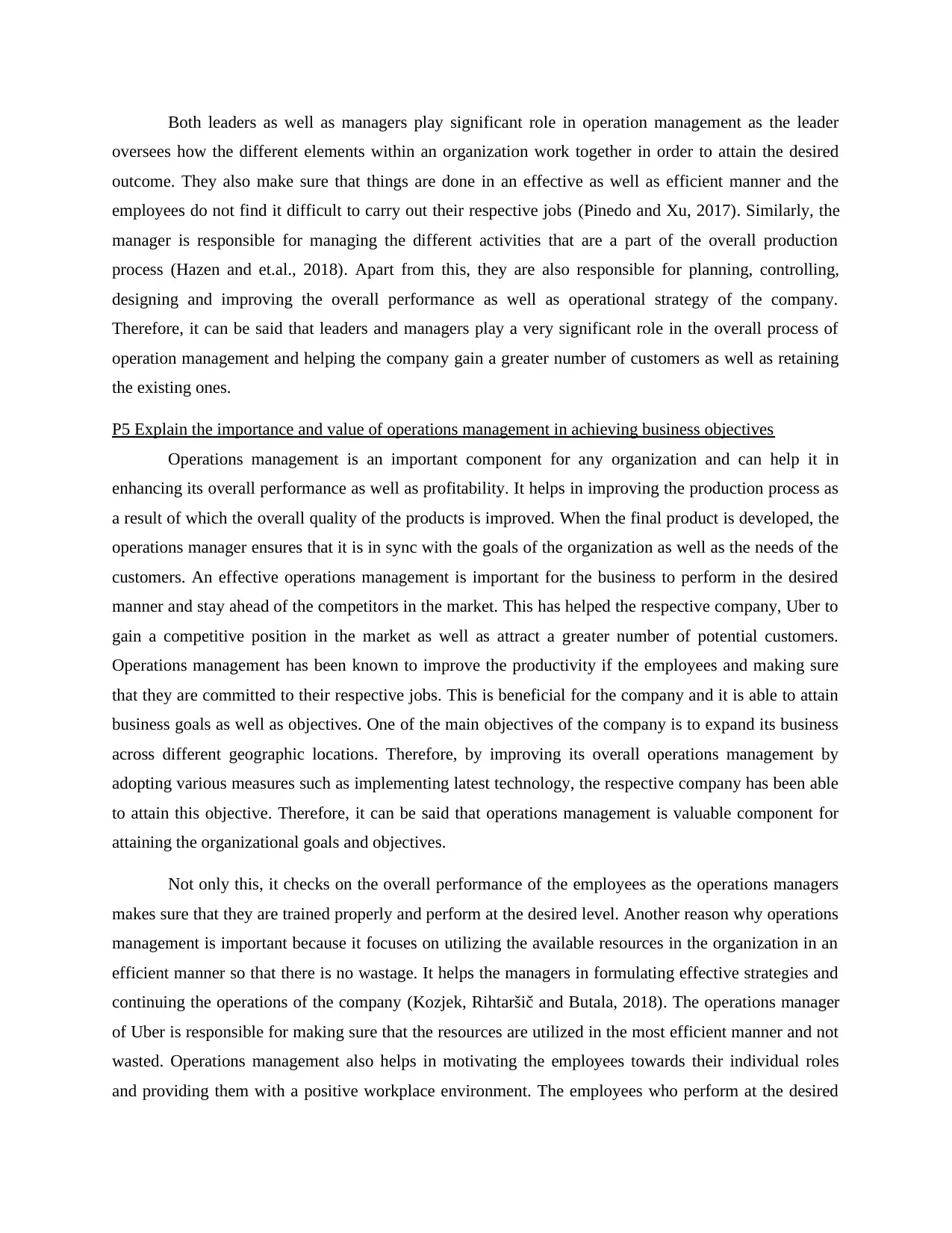
Both leaders as well as managers play significant role in operation management as the leader
oversees how the different elements within an organization work together in order to attain the desired
outcome. They also make sure that things are done in an effective as well as efficient manner and the
employees do not find it difficult to carry out their respective jobs (Pinedo and Xu, 2017). Similarly, the
manager is responsible for managing the different activities that are a part of the overall production
process (Hazen and et.al., 2018). Apart from this, they are also responsible for planning, controlling,
designing and improving the overall performance as well as operational strategy of the company.
Therefore, it can be said that leaders and managers play a very significant role in the overall process of
operation management and helping the company gain a greater number of customers as well as retaining
the existing ones.
P5 Explain the importance and value of operations management in achieving business objectives
Operations management is an important component for any organization and can help it in
enhancing its overall performance as well as profitability. It helps in improving the production process as
a result of which the overall quality of the products is improved. When the final product is developed, the
operations manager ensures that it is in sync with the goals of the organization as well as the needs of the
customers. An effective operations management is important for the business to perform in the desired
manner and stay ahead of the competitors in the market. This has helped the respective company, Uber to
gain a competitive position in the market as well as attract a greater number of potential customers.
Operations management has been known to improve the productivity if the employees and making sure
that they are committed to their respective jobs. This is beneficial for the company and it is able to attain
business goals as well as objectives. One of the main objectives of the company is to expand its business
across different geographic locations. Therefore, by improving its overall operations management by
adopting various measures such as implementing latest technology, the respective company has been able
to attain this objective. Therefore, it can be said that operations management is valuable component for
attaining the organizational goals and objectives.
Not only this, it checks on the overall performance of the employees as the operations managers
makes sure that they are trained properly and perform at the desired level. Another reason why operations
management is important because it focuses on utilizing the available resources in the organization in an
efficient manner so that there is no wastage. It helps the managers in formulating effective strategies and
continuing the operations of the company (Kozjek, Rihtaršič and Butala, 2018). The operations manager
of Uber is responsible for making sure that the resources are utilized in the most efficient manner and not
wasted. Operations management also helps in motivating the employees towards their individual roles
and providing them with a positive workplace environment. The employees who perform at the desired
oversees how the different elements within an organization work together in order to attain the desired
outcome. They also make sure that things are done in an effective as well as efficient manner and the
employees do not find it difficult to carry out their respective jobs (Pinedo and Xu, 2017). Similarly, the
manager is responsible for managing the different activities that are a part of the overall production
process (Hazen and et.al., 2018). Apart from this, they are also responsible for planning, controlling,
designing and improving the overall performance as well as operational strategy of the company.
Therefore, it can be said that leaders and managers play a very significant role in the overall process of
operation management and helping the company gain a greater number of customers as well as retaining
the existing ones.
P5 Explain the importance and value of operations management in achieving business objectives
Operations management is an important component for any organization and can help it in
enhancing its overall performance as well as profitability. It helps in improving the production process as
a result of which the overall quality of the products is improved. When the final product is developed, the
operations manager ensures that it is in sync with the goals of the organization as well as the needs of the
customers. An effective operations management is important for the business to perform in the desired
manner and stay ahead of the competitors in the market. This has helped the respective company, Uber to
gain a competitive position in the market as well as attract a greater number of potential customers.
Operations management has been known to improve the productivity if the employees and making sure
that they are committed to their respective jobs. This is beneficial for the company and it is able to attain
business goals as well as objectives. One of the main objectives of the company is to expand its business
across different geographic locations. Therefore, by improving its overall operations management by
adopting various measures such as implementing latest technology, the respective company has been able
to attain this objective. Therefore, it can be said that operations management is valuable component for
attaining the organizational goals and objectives.
Not only this, it checks on the overall performance of the employees as the operations managers
makes sure that they are trained properly and perform at the desired level. Another reason why operations
management is important because it focuses on utilizing the available resources in the organization in an
efficient manner so that there is no wastage. It helps the managers in formulating effective strategies and
continuing the operations of the company (Kozjek, Rihtaršič and Butala, 2018). The operations manager
of Uber is responsible for making sure that the resources are utilized in the most efficient manner and not
wasted. Operations management also helps in motivating the employees towards their individual roles
and providing them with a positive workplace environment. The employees who perform at the desired
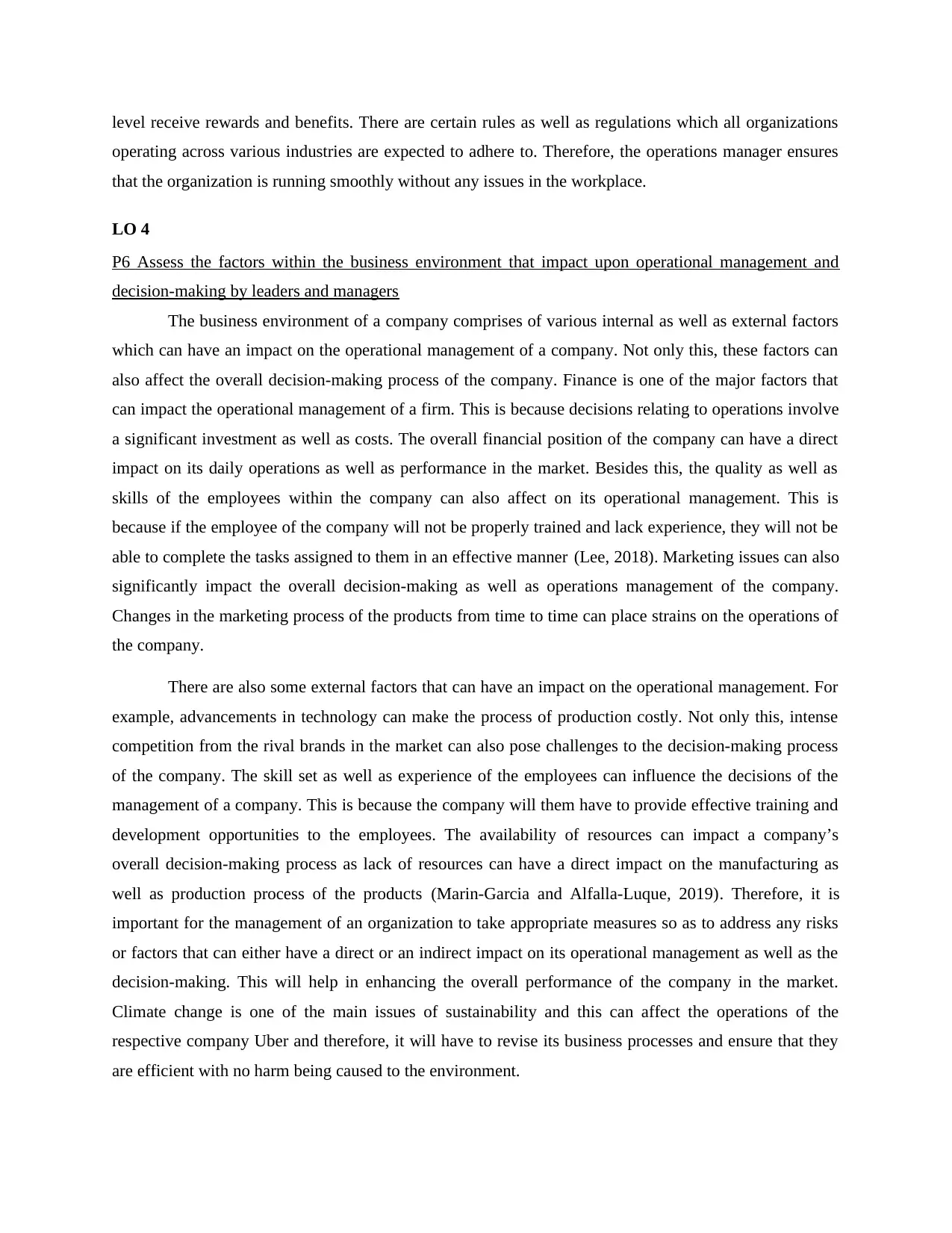
level receive rewards and benefits. There are certain rules as well as regulations which all organizations
operating across various industries are expected to adhere to. Therefore, the operations manager ensures
that the organization is running smoothly without any issues in the workplace.
LO 4
P6 Assess the factors within the business environment that impact upon operational management and
decision-making by leaders and managers
The business environment of a company comprises of various internal as well as external factors
which can have an impact on the operational management of a company. Not only this, these factors can
also affect the overall decision-making process of the company. Finance is one of the major factors that
can impact the operational management of a firm. This is because decisions relating to operations involve
a significant investment as well as costs. The overall financial position of the company can have a direct
impact on its daily operations as well as performance in the market. Besides this, the quality as well as
skills of the employees within the company can also affect on its operational management. This is
because if the employee of the company will not be properly trained and lack experience, they will not be
able to complete the tasks assigned to them in an effective manner (Lee, 2018). Marketing issues can also
significantly impact the overall decision-making as well as operations management of the company.
Changes in the marketing process of the products from time to time can place strains on the operations of
the company.
There are also some external factors that can have an impact on the operational management. For
example, advancements in technology can make the process of production costly. Not only this, intense
competition from the rival brands in the market can also pose challenges to the decision-making process
of the company. The skill set as well as experience of the employees can influence the decisions of the
management of a company. This is because the company will them have to provide effective training and
development opportunities to the employees. The availability of resources can impact a company’s
overall decision-making process as lack of resources can have a direct impact on the manufacturing as
well as production process of the products (Marin-Garcia and Alfalla-Luque, 2019). Therefore, it is
important for the management of an organization to take appropriate measures so as to address any risks
or factors that can either have a direct or an indirect impact on its operational management as well as the
decision-making. This will help in enhancing the overall performance of the company in the market.
Climate change is one of the main issues of sustainability and this can affect the operations of the
respective company Uber and therefore, it will have to revise its business processes and ensure that they
are efficient with no harm being caused to the environment.
operating across various industries are expected to adhere to. Therefore, the operations manager ensures
that the organization is running smoothly without any issues in the workplace.
LO 4
P6 Assess the factors within the business environment that impact upon operational management and
decision-making by leaders and managers
The business environment of a company comprises of various internal as well as external factors
which can have an impact on the operational management of a company. Not only this, these factors can
also affect the overall decision-making process of the company. Finance is one of the major factors that
can impact the operational management of a firm. This is because decisions relating to operations involve
a significant investment as well as costs. The overall financial position of the company can have a direct
impact on its daily operations as well as performance in the market. Besides this, the quality as well as
skills of the employees within the company can also affect on its operational management. This is
because if the employee of the company will not be properly trained and lack experience, they will not be
able to complete the tasks assigned to them in an effective manner (Lee, 2018). Marketing issues can also
significantly impact the overall decision-making as well as operations management of the company.
Changes in the marketing process of the products from time to time can place strains on the operations of
the company.
There are also some external factors that can have an impact on the operational management. For
example, advancements in technology can make the process of production costly. Not only this, intense
competition from the rival brands in the market can also pose challenges to the decision-making process
of the company. The skill set as well as experience of the employees can influence the decisions of the
management of a company. This is because the company will them have to provide effective training and
development opportunities to the employees. The availability of resources can impact a company’s
overall decision-making process as lack of resources can have a direct impact on the manufacturing as
well as production process of the products (Marin-Garcia and Alfalla-Luque, 2019). Therefore, it is
important for the management of an organization to take appropriate measures so as to address any risks
or factors that can either have a direct or an indirect impact on its operational management as well as the
decision-making. This will help in enhancing the overall performance of the company in the market.
Climate change is one of the main issues of sustainability and this can affect the operations of the
respective company Uber and therefore, it will have to revise its business processes and ensure that they
are efficient with no harm being caused to the environment.
⊘ This is a preview!⊘
Do you want full access?
Subscribe today to unlock all pages.

Trusted by 1+ million students worldwide
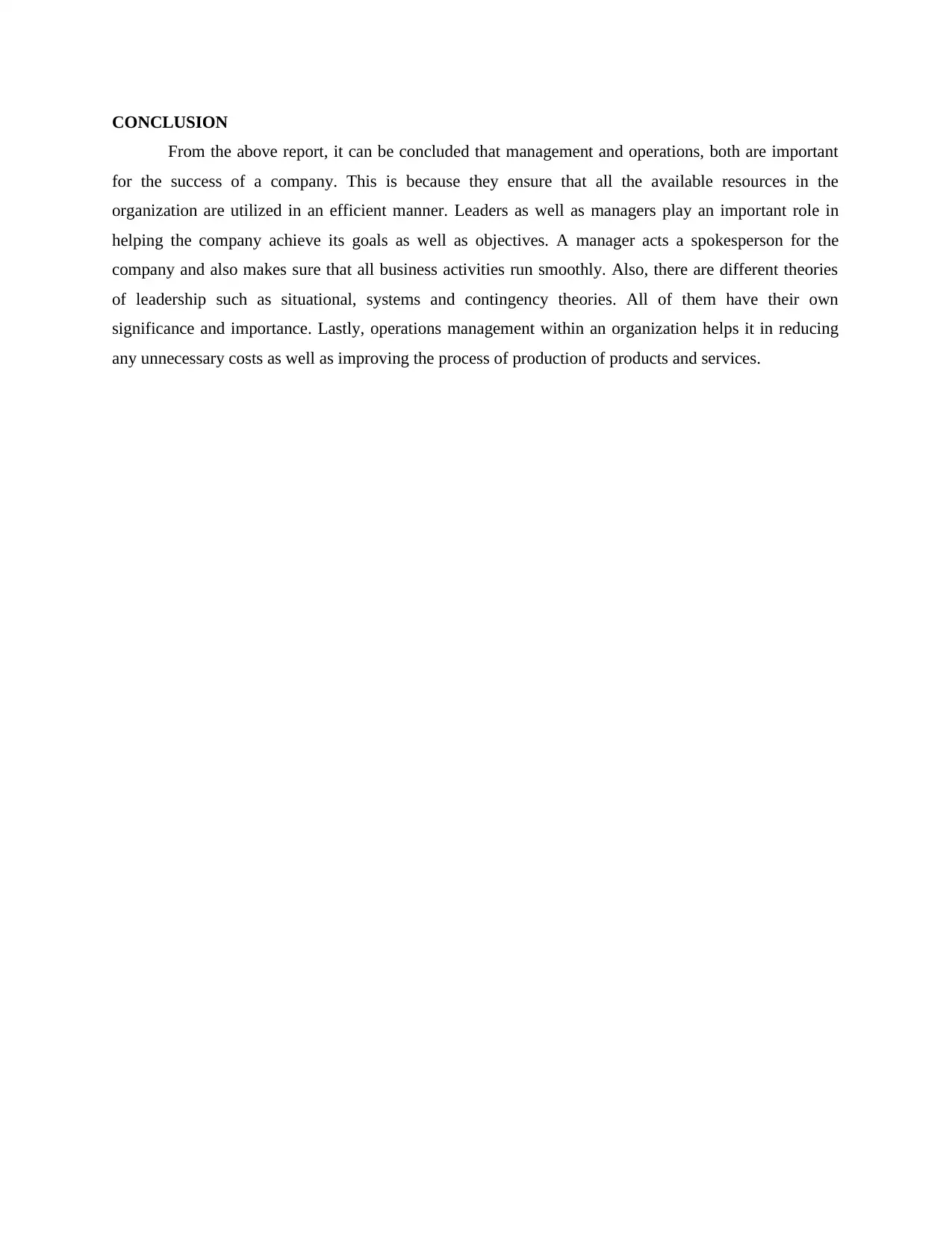
CONCLUSION
From the above report, it can be concluded that management and operations, both are important
for the success of a company. This is because they ensure that all the available resources in the
organization are utilized in an efficient manner. Leaders as well as managers play an important role in
helping the company achieve its goals as well as objectives. A manager acts a spokesperson for the
company and also makes sure that all business activities run smoothly. Also, there are different theories
of leadership such as situational, systems and contingency theories. All of them have their own
significance and importance. Lastly, operations management within an organization helps it in reducing
any unnecessary costs as well as improving the process of production of products and services.
From the above report, it can be concluded that management and operations, both are important
for the success of a company. This is because they ensure that all the available resources in the
organization are utilized in an efficient manner. Leaders as well as managers play an important role in
helping the company achieve its goals as well as objectives. A manager acts a spokesperson for the
company and also makes sure that all business activities run smoothly. Also, there are different theories
of leadership such as situational, systems and contingency theories. All of them have their own
significance and importance. Lastly, operations management within an organization helps it in reducing
any unnecessary costs as well as improving the process of production of products and services.
Paraphrase This Document
Need a fresh take? Get an instant paraphrase of this document with our AI Paraphraser
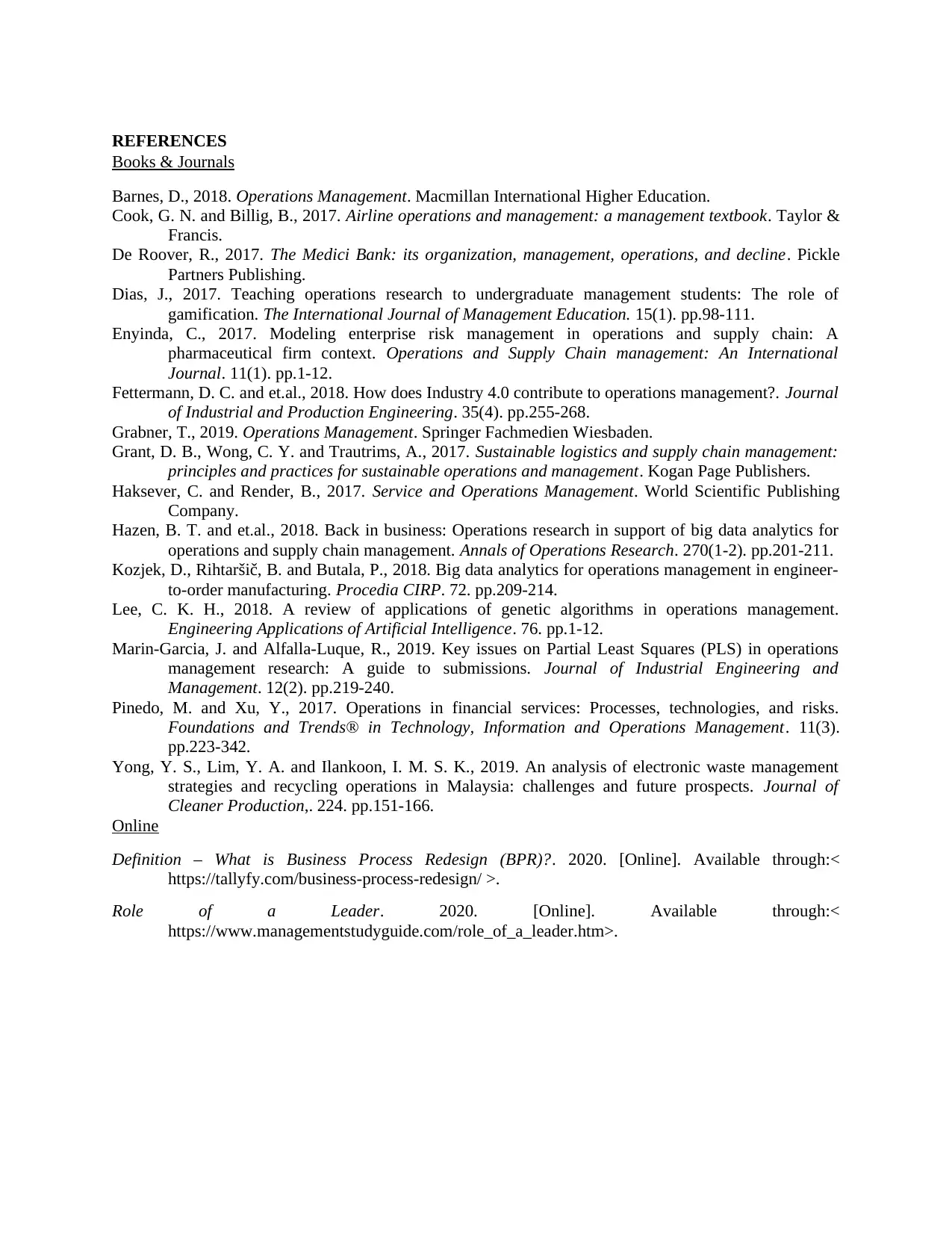
REFERENCES
Books & Journals
Barnes, D., 2018. Operations Management. Macmillan International Higher Education.
Cook, G. N. and Billig, B., 2017. Airline operations and management: a management textbook. Taylor &
Francis.
De Roover, R., 2017. The Medici Bank: its organization, management, operations, and decline. Pickle
Partners Publishing.
Dias, J., 2017. Teaching operations research to undergraduate management students: The role of
gamification. The International Journal of Management Education. 15(1). pp.98-111.
Enyinda, C., 2017. Modeling enterprise risk management in operations and supply chain: A
pharmaceutical firm context. Operations and Supply Chain management: An International
Journal. 11(1). pp.1-12.
Fettermann, D. C. and et.al., 2018. How does Industry 4.0 contribute to operations management?. Journal
of Industrial and Production Engineering. 35(4). pp.255-268.
Grabner, T., 2019. Operations Management. Springer Fachmedien Wiesbaden.
Grant, D. B., Wong, C. Y. and Trautrims, A., 2017. Sustainable logistics and supply chain management:
principles and practices for sustainable operations and management. Kogan Page Publishers.
Haksever, C. and Render, B., 2017. Service and Operations Management. World Scientific Publishing
Company.
Hazen, B. T. and et.al., 2018. Back in business: Operations research in support of big data analytics for
operations and supply chain management. Annals of Operations Research. 270(1-2). pp.201-211.
Kozjek, D., Rihtaršič, B. and Butala, P., 2018. Big data analytics for operations management in engineer-
to-order manufacturing. Procedia CIRP. 72. pp.209-214.
Lee, C. K. H., 2018. A review of applications of genetic algorithms in operations management.
Engineering Applications of Artificial Intelligence. 76. pp.1-12.
Marin-Garcia, J. and Alfalla-Luque, R., 2019. Key issues on Partial Least Squares (PLS) in operations
management research: A guide to submissions. Journal of Industrial Engineering and
Management. 12(2). pp.219-240.
Pinedo, M. and Xu, Y., 2017. Operations in financial services: Processes, technologies, and risks.
Foundations and Trends® in Technology, Information and Operations Management. 11(3).
pp.223-342.
Yong, Y. S., Lim, Y. A. and Ilankoon, I. M. S. K., 2019. An analysis of electronic waste management
strategies and recycling operations in Malaysia: challenges and future prospects. Journal of
Cleaner Production,. 224. pp.151-166.
Online
Definition – What is Business Process Redesign (BPR)?. 2020. [Online]. Available through:<
https://tallyfy.com/business-process-redesign/ >.
Role of a Leader. 2020. [Online]. Available through:<
https://www.managementstudyguide.com/role_of_a_leader.htm>.
Books & Journals
Barnes, D., 2018. Operations Management. Macmillan International Higher Education.
Cook, G. N. and Billig, B., 2017. Airline operations and management: a management textbook. Taylor &
Francis.
De Roover, R., 2017. The Medici Bank: its organization, management, operations, and decline. Pickle
Partners Publishing.
Dias, J., 2017. Teaching operations research to undergraduate management students: The role of
gamification. The International Journal of Management Education. 15(1). pp.98-111.
Enyinda, C., 2017. Modeling enterprise risk management in operations and supply chain: A
pharmaceutical firm context. Operations and Supply Chain management: An International
Journal. 11(1). pp.1-12.
Fettermann, D. C. and et.al., 2018. How does Industry 4.0 contribute to operations management?. Journal
of Industrial and Production Engineering. 35(4). pp.255-268.
Grabner, T., 2019. Operations Management. Springer Fachmedien Wiesbaden.
Grant, D. B., Wong, C. Y. and Trautrims, A., 2017. Sustainable logistics and supply chain management:
principles and practices for sustainable operations and management. Kogan Page Publishers.
Haksever, C. and Render, B., 2017. Service and Operations Management. World Scientific Publishing
Company.
Hazen, B. T. and et.al., 2018. Back in business: Operations research in support of big data analytics for
operations and supply chain management. Annals of Operations Research. 270(1-2). pp.201-211.
Kozjek, D., Rihtaršič, B. and Butala, P., 2018. Big data analytics for operations management in engineer-
to-order manufacturing. Procedia CIRP. 72. pp.209-214.
Lee, C. K. H., 2018. A review of applications of genetic algorithms in operations management.
Engineering Applications of Artificial Intelligence. 76. pp.1-12.
Marin-Garcia, J. and Alfalla-Luque, R., 2019. Key issues on Partial Least Squares (PLS) in operations
management research: A guide to submissions. Journal of Industrial Engineering and
Management. 12(2). pp.219-240.
Pinedo, M. and Xu, Y., 2017. Operations in financial services: Processes, technologies, and risks.
Foundations and Trends® in Technology, Information and Operations Management. 11(3).
pp.223-342.
Yong, Y. S., Lim, Y. A. and Ilankoon, I. M. S. K., 2019. An analysis of electronic waste management
strategies and recycling operations in Malaysia: challenges and future prospects. Journal of
Cleaner Production,. 224. pp.151-166.
Online
Definition – What is Business Process Redesign (BPR)?. 2020. [Online]. Available through:<
https://tallyfy.com/business-process-redesign/ >.
Role of a Leader. 2020. [Online]. Available through:<
https://www.managementstudyguide.com/role_of_a_leader.htm>.
1 out of 11
Related Documents
Your All-in-One AI-Powered Toolkit for Academic Success.
+13062052269
info@desklib.com
Available 24*7 on WhatsApp / Email
![[object Object]](/_next/static/media/star-bottom.7253800d.svg)
Unlock your academic potential
Copyright © 2020–2025 A2Z Services. All Rights Reserved. Developed and managed by ZUCOL.





